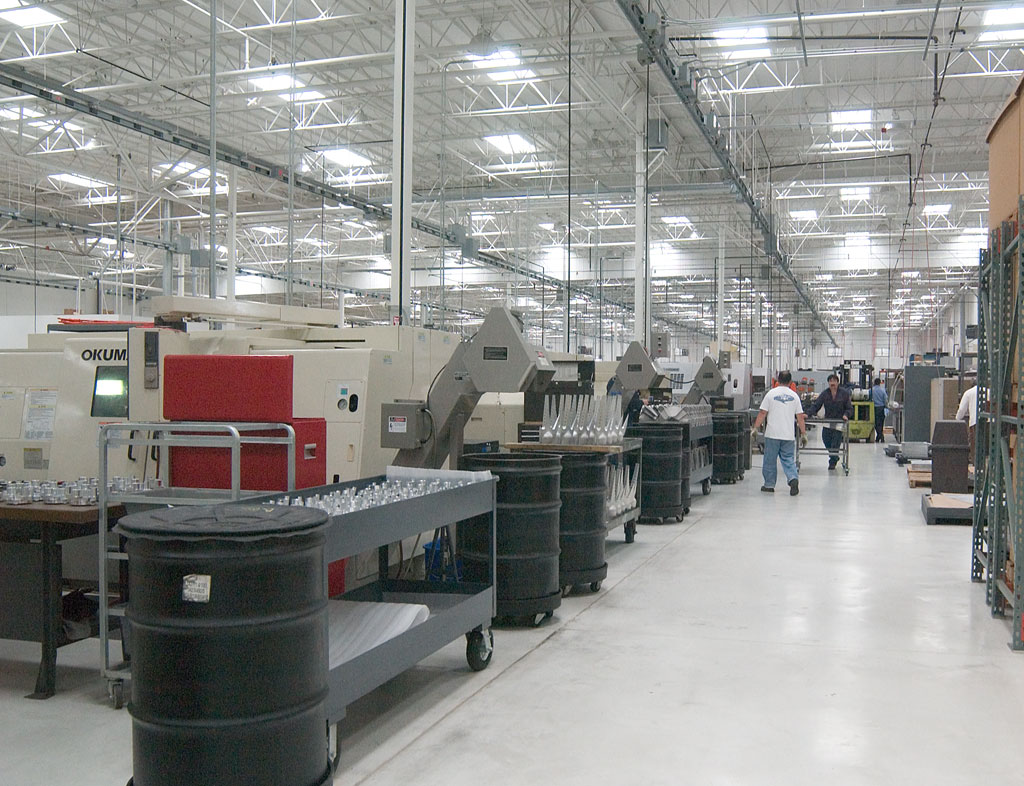
Photo courtesy of Robinson Helicopter Company

Photo courtesy of Robinson Helicopter Company
Back in 1997 I helped my friend Anne bring her R22 back to Boston from the factory, and by then Robinson had moved into a wonderful new building on Airport Drive. In the picture at the top of this page, that is the section of the building to the upper right. The employees now call that the "old" building, and the portion to the lower left of the picture is called the "new building".
The entire safety course group was given a tour of the factory, and a lot of people in my group mentioned what an amazing factory it is. For one, it's huge. You can see that in the picture above. It's also amazingly clean and well lit. In the following picture you can see that there are many skylights built into the ceiling of the building. This allows the workplace to be lit by natural light, saving electricity. It also gives the inside of the building a really bright clean feeling. You can see in this picture that there are lights on the ceiling which are not turned on. They are only turned on when weather prevents sufficient sunlight from illuminating the factory floor.

Photo courtesy of Robinson Helicopter Company
During the class tour of the factory, we were able to see almost every part of the factory. Gavino explained that there would only be a few sections of the factory that I would be allowed to photograph. I'll try to explain what I was able to see on my tour, but not to photograph. First of all, unlike a company like Boeing that has many many subcontractors producing large portions of their aircraft, Robinson makes over 80% of their helicopters in this factory. We were able to see on the tour large stocks of steel and aluminium to be processed into all the different parts of the helicopters. The factory literally takes raw materials in one side, machines thousands of different parts, and then assembles those parts into a working helicopter. We were told that the reason Robinson does so much of the manufacturing themselves is so that they can maintain an extremely high level of quality.

All remaining pictures are Copyright(c) Paul Cantrell, 2006
Another thing that surprised me about the Robinson factory was the amount of high tech production machinery. I remember even in the old Crenshaw Blvd building that they had some high tech machines, but in the current factory there are row after row of them. In the above picture, you can see various parts that have been machined, and are waiting for the next step in the manufacturing process. The pointy objects approximately in the middle of the picture are part of the blade grip assembly. I can't identify the rest of the parts you can see, but the factory is filled with gleaming objects machined from steel and aluminium.

There is a fair amount of sheet metal in a helicopter, and during the tour we were able to see a water jet machine cutting sheets of aluminum into various shapes, including all the holes for screws, rivets, and accessories. The water jet produces a smooth cut that does not need to be deburred. We were able to touch a freshly cut sheet of aluminium, and the cuts were smooth to the touch. Really cool. The factory also has laser systems for cutting steel, as well as large hydraulic presses for cutting and shaping aluminium parts. Frankly, if you had told me they were building Space Stations, I would probably have believed you - it was that high tech.
Part Two -- lots more pictures of the plant...